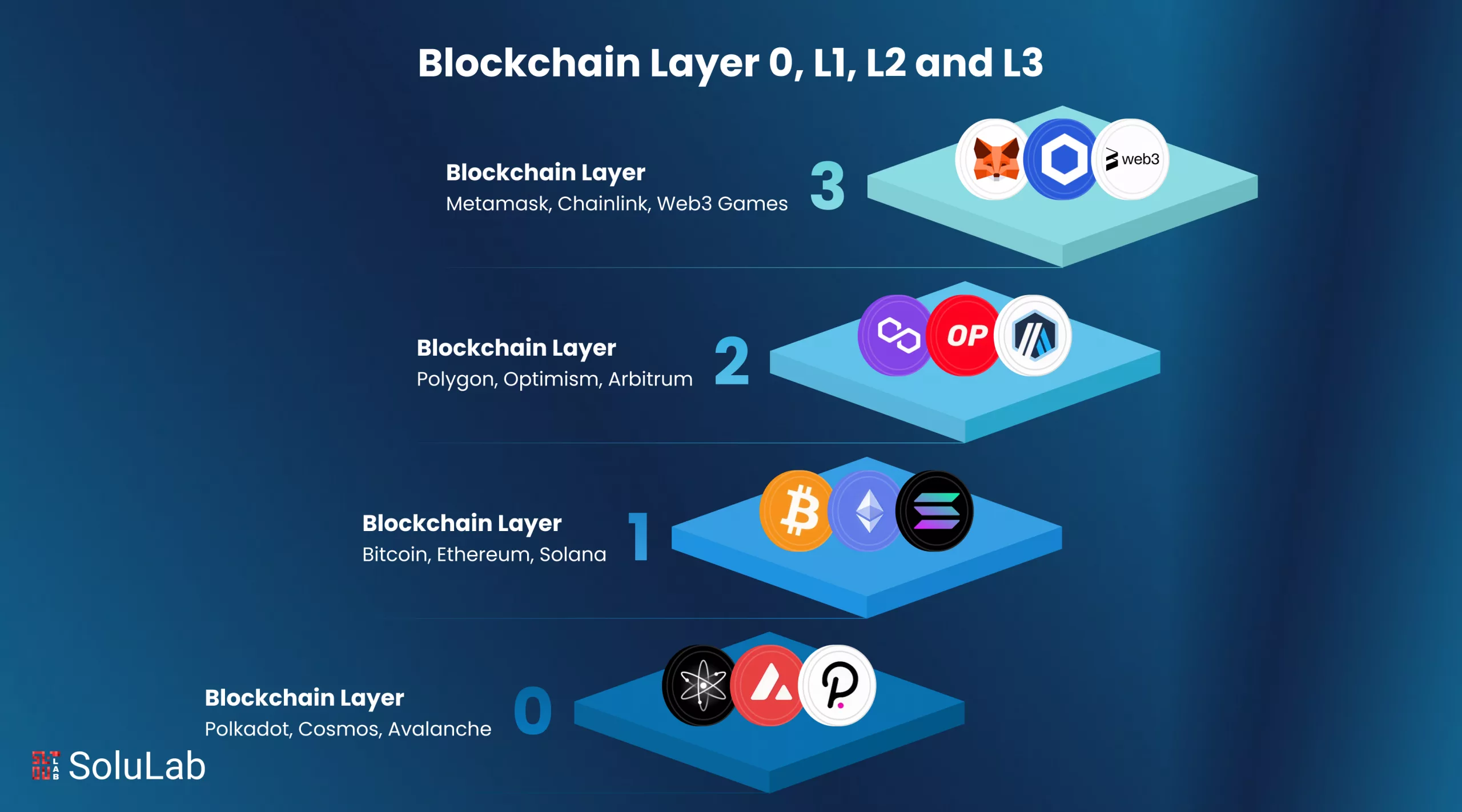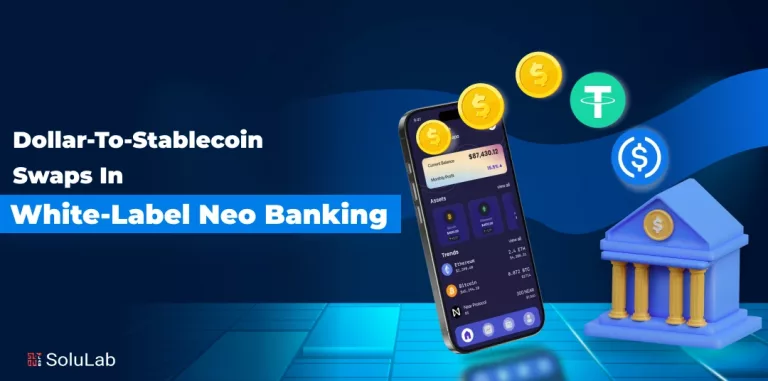
Blockchain technology is growing fast to meet the rising need for better speed, security, and decentralization. As per the World Economic Forum, the total value of crypto assets has passed $1.7 trillion, with more than 3,000 decentralized apps (dApps) live on various blockchain platforms.
As more people and businesses adopt this tech, it’s important to understand how different layers in blockchain work together. From the base infrastructure of Layer 0 to the user-facing apps in Layer 3, each layer plays a key role in making the system faster, safer, and easier to use.
This blog will break down each of the different layers in blockchain in simple terms, so you can clearly see how they work and what role they play in building powerful, scalable Web3 and AI products.
What Are The Layers Of Blockchain?
A blockchain isn’t just one system or a single line of code, it’s made up of multiple blockchain architecture layers, each playing a unique role. These layers of blockchain technology work together to make blockchains more secure, faster, and easier to use.
This structure also helps solve the well-known blockchain trilemma: balancing security, scalability, and decentralization.
Here they are:
- Layer 0: This is the base. It includes all the behind-the-scenes parts like networking, data transfer, and how different blockchain platforms connect and talk to each other.
- Layer 1: The core layer of the system. It runs the main blockchain protocol like Ethereum, Bitcoin, or Solana. It handles things like data validation and transaction recording.
- Layer 2: This layer sits on top of Layer 1. It improves the speed and reduces the costs of using the blockchain. Tools like Polygon and Arbitrum are popular here.
- Layer 3: This is what users see. It includes apps like wallets, games, or any tool that lets people interact with the blockchain. These apps are built using the foundation and upgrades of the other layers.
Why Use a Layered Blockchain Structure?
Using layers in blockchain technology makes the system more organized and flexible. It lets developers upgrade certain features without changing everything. For example:
- Layers can improve speed with tools like rollups or sidechains.
- Platforms can scale more easily without giving up security.
- Services like Blockchain-as-a-Service help businesses use blockchain tech without building from scratch.
It also supports more complex systems like cross-chain multi-asset management platforms, which let users interact with different blockchains all in one place, improving blockchain interoperability.
What is Layer 0?
Layer 0 is the base layer of a blockchain network. It includes all the core systems like networking, hardware infrastructure, consensus protocols, and peer discovery mechanisms. It is the operating system of a blockchain.
Key Roles of Layer 0
- Provides the base network for all other blockchain layers to build on
- Manages consensus and communication between blockchains
- Enables security and scalability at the foundational level
Interoperability & Cross-Chain Communication
Layer 0 allows different blockchains to talk to each other using technologies like Cosmos’ IBC and Polkadot’s Relay Chain. This enables multi-chain vs. cross-chain transactions and boosts blockchain interoperability.
Examples of Layer 0 Projects
- Polkadot: Uses parachains to connect multiple blockchains
- Cosmos: Enables communication between chains with IBC
- Avalanche: Offers high throughput and fast finality
These are widely used blockchain platforms for building scalable and secure ecosystems.
What is Layer 1?
Layer 1 is where the actual blockchain protocol lives. It defines how the network operates, how consensus is reached, and how transactions are verified.
Core Features
- Implements consensus methods like PoW and PoS
- Handles transaction validation and security
- Hosts the native tokens of the blockchain
Popular Layer 1 Blockchains
- Bitcoin – Uses Proof-of-Work for secure transactions
- Ethereum – Powers smart contracts and DeFi apps
- Solana – Known for high-speed, low-cost transactions
These are strong examples of layer 1 blockchains and are among the top blockchain development companies by adoption.
What is Layer 2?
Layer 1 can get slow and expensive. Layer 2 helps by processing transactions faster and more cheaply, then reporting back to Layer 1.
Main Techniques
- Rollups: Bundle multiple transactions into one
- Sidechains: Operate independently but report to Layer 1
- State Channels: Enable instant payments between users
Key Projects
- Polygon – Layer 2 scaling for Ethereum
- Arbitrum – Optimistic Rollup for speed and low gas
- Optimism – Simple scaling using Rollups
This is where the Layer 1 vs Layer 2 vs Layer 3 trade-off becomes important for businesses looking to optimize cost and speed.
What is Layer 3?
Layer 3 is the user-facing part of the blockchain. It includes apps, interfaces, and APIs that connect users to the blockchain.
Key Uses
- Supports dApps (Decentralized Applications)
- Provides UI/UX for wallets, exchanges, games, etc.
- Bridges AI and smart contract technologies
Examples
- Metamask – A wallet extension for Ethereum
- Chainlink Oracles – Connect real-world data to smart contracts
- Web3 Games – On-chain games that reward players with tokens
With more demand for intelligent systems, AI agents and AI development companies are being integrated into layer 3 blockchain platforms to enhance automation and personalization.
Differences Between Layer 0, Layer 1, Layer 2, and Layer 3
The blockchain ecosystem is made up of multiple layers, each playing a unique role in how decentralized networks function, scale, and interact. Here’s a simple breakdown of Layer 0 to Layer 3 and how they differ:
| Layer | Main Function | Key Technologies | Examples | Who It’s For |
| Layer 0 | Base infrastructure for blockchains; handles networking and consensus | IBC (Cosmos), Relay Chain (Polkadot), Avalanche consensus | Polkadot, Cosmos, Avalanche | Developers building interoperable or multi-chain ecosystems |
| Layer 1 | Core blockchain protocol manages transactions and consensus | PoW, PoS, Smart Contracts | Bitcoin, Ethereum, Solana | Startups & enterprises launching tokens, smart contracts, or DeFi apps |
| Layer 2 | Offloads transaction load to scale Layer 1; enhances speed and reduces cost | Rollups, Sidechains, State Channels | Polygon, Optimism, Arbitrum | Projects needing faster, cheaper transactions for scalability |
| Layer 3 | Application layer that connects users with the blockchain | dApps, APIs, Wallets, Oracles, AI agents | Metamask, Chainlink, Web3 Games | Businesses focusing on UI/UX, user growth, or integrating AI with Web3 |
How do Blockchain Layers Work Together?

Blockchain layers aren’t isolated; they’re designed to work together as a stack, each serving a unique purpose while enhancing the overall functionality, scalability, and user experience of blockchain networks.
Here’s how these layers interact:
Vertical and Horizontal Interactions
Blockchain layers stack vertically. Layer 2 builds on Layer 1, which runs on Layer 0. They also connect horizontally through chain abstraction for blockchain interoperability.
Building a Modular and Scalable Web3
Each of the different layers of blockchain can evolve independently. This modular setup supports better upgrades and innovations, vital for blockchain in healthcare and blockchain in trade finance.
Key Responsibilities by Layers
- Layers 0 & 1 ensure core security and network integrity.
- Layer 2 offers scalability through efficient processing.
- Layer 3 enhances user interaction and usability.
Choosing the right combination depends on your application’s goal, whether performance, decentralization, or user experience is the priority.
What Is Scalability in Blockchain?
Scalability in blockchain refers to a network’s ability to handle a growing number of transactions, users, and applications efficiently, without slowing down or becoming too expensive to use.
In simple terms, a blockchain is scalable if it can grow and serve more people without sacrificing speed, cost, or security.
The Blockchain Trilemma
Scalability, decentralization, and security by achieving all three is challenging. Layers of blockchain solve this by dividing responsibilities across layers.
How Layers Solve Scalability Challenges?
- Layers 0 & 1 maintain decentralization and trust
- Layers 2 & 3 improve performance and user experience
Real-World Use Cases
- Gaming: Smooth gameplay with Layer 2 scaling
- Logistics: Faster, cheaper tracking with decentralized ledgers
- Finance: Secure trading with reduced latency
These highlight the importance of blockchain use cases in designing performant applications.
Performance Metrics and Tradeoffs
- TPS (Transactions Per Second)
- Gas fees (cost per transaction)
- Latency (speed to finalize transactions)
Layer 2 can deliver 100x throughput over Layer 1 alone.
Conclusion
The future of decentralized tech lies in how we leverage each of the blockchain layers. Whether you’re building a DeFi protocol or a retail app powered by AI, understanding this layered model helps you make smarter blockchain architecture layers decisions.
If you’re looking to scale or optimize your blockchain strategy, SoluLab is a trusted blockchain development company in the USA with real-world experience in implementing multi-layer systems. The team is well-versed in rendering top-notch solutions powered by a next-gen tech stack. Recently, SoluLab enabled OBORTECH to utilize Blockchain-as-a-Service (BaaS) to launch scalable blockchain applications without backend complexity, showcasing our expertise in enterprise blockchain development.
Whether you are planning to integrate blockchain or have a unique idea to build, we can cater to all your needs with the best solutions. Contact us!
FAQs
1. Which layer is best for developers to build on?
It depends on the project. Layer 1 is ideal for building secure and decentralized protocols. Layer 2 offers speed and cost-efficiency for apps that need scalability. Layer 3 is great for building user-friendly front-end experiences.
2. Can a blockchain work without Layer 0 or 3?
No, Layer 0 is the base. Layer 3 isn’t required for technical function but is essential for real-world usability.
3. Can a blockchain project operate across multiple layers?
Yes! Many modern blockchain projects use a combination of layers. For example, a DApp (Layer 3) might run on a Layer 2 solution like Arbitrum, which itself is secured by a Layer 1 blockchain like Ethereum, all connected via a Layer 0 protocol like Cosmos.
4. How do these layers benefit enterprise blockchain projects?
Enterprises can use Layer 0 for cross-chain operations, Layer 1 for secure data storage, Layer 2 for scaling high-volume use cases, and Layer 3 for creating user-friendly apps, making the tech stack modular, scalable, and enterprise-ready.






